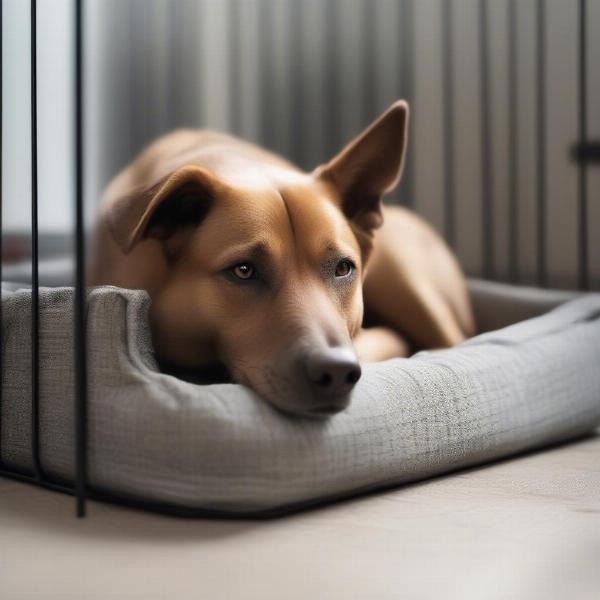Growling is a natural canine communication method, but when your dog seems to be growling at thin air, it can be unsettling. Understanding why your dog is growling at nothing requires looking at potential causes, ranging from medical reasons to environmental factors. This article will explore the common reasons behind this behavior and guide you on how to address it effectively.
Medical Reasons for Seemingly Random Growling
Sometimes, a dog’s seemingly unprovoked growling can stem from underlying medical conditions. Pain, discomfort, or sensory changes can trigger growling episodes. For example, dogs experiencing arthritis pain might growl if they shift position and experience a sudden twinge. Similarly, vision or hearing impairments can lead to confusion and anxiety, manifesting as growling at perceived threats they can’t clearly identify. If your dog’s growling behavior is new or accompanied by other symptoms like changes in appetite, lethargy, or restlessness, a veterinary check-up is crucial.
Environmental Triggers and Phantom Growling
Even subtle environmental changes can trigger growling in dogs. High-pitched noises inaudible to humans, like the hum of certain appliances, can cause discomfort and lead to growling. Similarly, unusual smells or changes in lighting can also be perceived as threats, prompting a growling response. Consider whether any new sounds, smells, or visual stimuli have been introduced into your dog’s environment that could be contributing to this behavior.
Cognitive Dysfunction and Growling in Senior Dogs
As dogs age, they can experience cognitive decline, similar to dementia in humans. This can lead to confusion, disorientation, and anxiety, often resulting in seemingly random growling. If your senior dog starts growling at nothing, particularly at night, it could be a sign of cognitive dysfunction syndrome (CDS). Consult your veterinarian for a diagnosis and discuss management strategies to improve your dog’s quality of life.
Fear, Anxiety, and Territorial Growling
Fear and anxiety are significant contributors to growling behavior. Even if you can’t identify the trigger, your dog might be responding to an internal fear or anxiety. This is especially true for dogs with a history of trauma or abuse. Territorial growling can also manifest as growling at seemingly nothing if the dog perceives a threat to their space, even if the “threat” is invisible to you.
How to Address Your Dog’s Growling
- Veterinary Check-up: The first step is to rule out any underlying medical conditions.
- Identify and Eliminate Triggers: Observe your dog carefully to identify any potential environmental triggers.
- Create a Safe Space: Provide your dog with a quiet, comfortable den where they can retreat when feeling stressed.
- Positive Reinforcement Training: Reward calm behavior and gradually desensitize your dog to any identified triggers.
- Consult a Professional: If the growling persists, seek help from a certified dog trainer or veterinary behaviorist.
 Dog in a safe space
Dog in a safe space
Conclusion
When your dog growls at nothing, it’s essential to take it seriously and investigate the underlying causes. While it can be a sign of medical issues, environmental factors, or emotional distress, understanding the root cause is crucial for effective management. By addressing the problem proactively and seeking professional guidance when necessary, you can help your dog feel safer and more secure, reducing the incidence of this concerning behavior.
FAQ
- Is it normal for a dog to growl at nothing? While growling is a natural communication method, growling at seemingly nothing warrants investigation to determine the underlying cause.
- Should I punish my dog for growling? Punishing growling can suppress the behavior without addressing the root cause and may lead to more dangerous, unpredictable actions.
- Can growling at nothing be a sign of aggression? Not necessarily. Growling is often a sign of fear, anxiety, or discomfort rather than aggression.
- How can I tell if my dog’s growling is due to pain? Look for other signs of pain or discomfort, such as limping, changes in appetite, or reluctance to be touched.
- When should I contact a veterinarian about my dog’s growling? If the growling is new, frequent, or accompanied by other behavioral or physical changes, consult your veterinarian.
- What can a veterinary behaviorist do to help? A veterinary behaviorist can assess your dog’s behavior, identify the underlying causes, and develop a tailored treatment plan.
- How long does it take to address growling behavior? The time required varies depending on the underlying cause and the dog’s individual response to treatment.
Related Articles
ILM Dog is your trusted resource for expert advice on all aspects of dog care, from breed selection and puppy care to senior dog health and behavior. We offer practical, up-to-date information to help you provide the best possible care for your canine companion. Whether you’re a seasoned dog owner or a new pet parent, ILM Dog is here to support you every step of the way. We specialize in dog breeds, health, training, nutrition, and more. Contact us today for personalized guidance! Email: [email protected], Phone: +44 20-3965-8624.